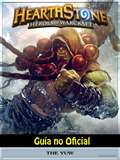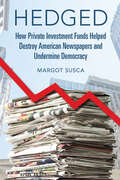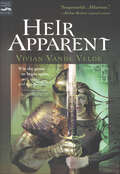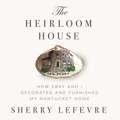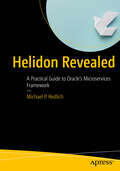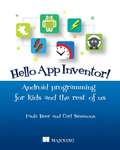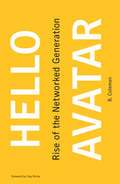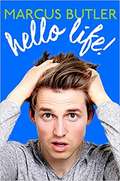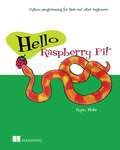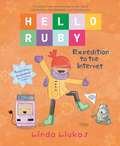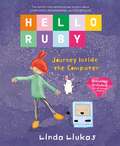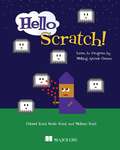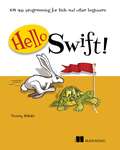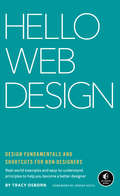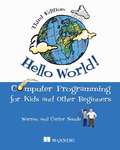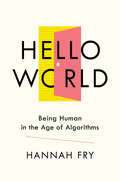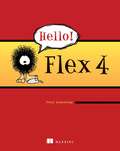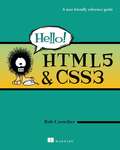- Table View
- List View
Hearthstone Heroes of Warcraft Guide non officiel
by Gaëlle Guilleaume Hiddenstuff Entertainment Josh AbbottGrâce à ce guide, vous deviendrez un joueur expérimenté et battrez tous vos adversaires ! Ce guide complet vous apprendra tout ce qu'il faut savoir sur ce jeu et vous fournira des stratégies, des conseils et plein d'astuces. Découvrez toutes les classes de héros, les quêtes, les hauts faits, l'élaboration des decks et différentes stratégies de joueurs professionnels ! Et bien d'autres choses encore ! Achetez-le et écrasez tous vos adversaires ! Informations légales : Ce produit n'est pas lié, affilié, soutenu, sponsorisé, corrigé ni certifié par Blizzard Entertainment. Ce guide ne modifie et n'altère en aucun cas le jeu. Il s'agit d'un guide écrit et non d'un programme.
Hearthstone Héroes of Warcraft Guía no Oficial
by Hiddenstuff Entertainment Josh Abbott Lizeth Nungaray¡Con mi guía de Juego, aprenderás lo que se necesita para ser un jugador experto y vencer a tus oponentes! Esto es una guía completa con todo lo que necesitas saber sobre el juego y MÁS, podrás descargar tu copia gratis del juego con esta compra. -Estrategías y consejos Profesionales. -Atajos y secretos. -Todas las clases de Héroes. -Todo sobre Búsquedas y Logros. -Todo sobre armar barajas. -Todo sobre construir cartas. -¡Secretos, consejos, atajos, desbloqueables, y trucos usados por jugadores Profesionales! -Información parecida a una wiki y estrategías. -Estrategias generales de app para principiantes. -¡Y MÁS! ¡Cómprala ahora y destroza a tus oponentes! ¡Conviértete hoy en un jugador profesional Aclaración: Este producto no está asociado, afiliado, certificado o patrocinado por Blizzard Entertainment. Esta guía será usada como referencia y como tal, no modifica de alguna forma el juego. Esta es una guía escrita y no un programa.
Hearthstone: Innkeeper's Tavern Cookbook
by Chelsea Monroe-CasselSheathe your sword and summon more than fifty delicious bites and cocktails inspired by the smash-hit game—perfect for any Fireside Gathering.From the bestselling author of World of Warcraft: The Official Cookbook and A Feast of Ice and Fire: The Official Game of Thrones Companion Cookbook comes a new collection of delicious recipes.With the Innkeeper’s Tavern Cookbook, fans will unlock Hearthstone-inspired eats, cocktails, and mocktails. A replica of Harth Stonebrew’s own private cookbook, this delightful guide contains more than fifty all-new recipes perfect for any Fireside Gathering or game night, from Sarge’s Easy Mac & Cheese to Medivh’s favorite martini—and, of course, funnel cake. Complete with mouthwatering color photos and Harth’s personal notations, recipe modifications, and reflections, the Innkeeper’s Tavern Cookbook brings the world of Hearthstone to life like never before. Hearthstone is a fast-paced digital card game where players sling spells, summon minions, and command powerful heroes in duels of epic strategy. Featuring familiar characters from the Warcraft® universe, Hearthstone has won over legions of fans with its humor and deceptively simple gameplay.
Hedged: How Private Investment Funds Helped Destroy American Newspapers and Undermine Democracy (The History of Media and Communication)
by Margot SuscaThe untold history of an American catastrophe The ultrawealthy largely own and guide the newspaper system in the United States. Through entities like hedge funds and private equity firms, this investor class continues to dismantle the one institution meant to give voice to average citizens in a democracy. Margot Susca reveals the little-known history of how private investment took over the newspaper industry. Drawing on a political economy of media, Susca’s analysis uses in-depth interviews and documentary evidence to examine issues surrounding ownership and power. Susca also traces the scorched-earth policies of layoffs, debt, cash-outs, and wholesale newspaper closings left behind by private investors and the effects of the devastation on the future of news and information. Throughout, Susca reveals an industry rocked less by external forces like lost ad revenue and more by ownership and management obsessed with profit and beholden to private fund interests that feel no responsibility toward journalism or the public it is meant to serve.
Heir Apparent (Rasmussem Corporation)
by Vivian Vande VeldeIn Heir Apparent there are as many ways to win as there are to get killed. "A stylish tale [that] addresses both fantasy gaming and censorship." (New York Times Book Review)From Edgar Award–winning author Vivian Vande Velde comes a rollicking story that puts a high-tech twist on the classic medieval fantasy-adventure.In the virtual reality game Heir Apparent, there are way too many ways to get killed—and Giannine seems to be finding them all. Which is a shame, because unless she can get the magic ring, locate the stolen treasure, answer the dwarf's dumb riddles, impress the head-chopping statue, charm the army of ghosts, fend off the barbarians, and defeat the man-eating dragon, she'll never win.And she has to, because losing means she'll die—for real this time.Junior Library Guild Selection * New York Public Library Book for the Teen Age
Heirloom House: How eBay and I Decorated and Furnished My Nantucket Home
by Sherry LefevreInspiration for Every Home Decorator with a Passion for the Past The Heirloom House is a humorous personal account of two interlocking obsessions: eBay and the quest to create a vacation house that looks and feels like a family heirloom. Beginning with recollections of her childhood summers in Nantucket, author Sherry Lefevre narrates the development of her personal aesthetic: wanting everything people with old inherited houses have. When she receives a bequest that allows her to purchase her own ramshackle summerhouse, she clicks on eBay and emerges two months later with a house fully furnished with other people’s ancestral treasures, from toile curtains to taxidermy, at a more-than-affordable price. Filled with photos and drawings, The Heirloom House invites readers to follow Lefevre’s eBay searches and imitate her heirloom-hunting strategies. Antique treasures are classified and eBay "search words” are suggested to assist the reader’s own treasure hunting. Anecdotes, both informative and entertaining, enliven descriptions of the antique objects acquired, and while the whole endeavor is relayed with humor, the underlying message is a serious one: with enough love, anyone can have an ancestral home--an heirloom house.
Helidon Revealed: A Practical Guide to Oracle’s Microservices Framework
by Michael P. RedlichThis book is your comprehensive introduction to Project Helidon, Oracle’s Java-based microservices framework for building cloud-native applications. The book introduces the two flavors of Helidon—Helidon SE and Helidon MP—and shows how to quickly build applications with each one. The book begins by placing the Helidon framework in context and explaining the MicroProfile and Jakarta EE specifications that underlie the building of microservices-based applications. From there, you will learn about the individual components of Helidon SE and Helidon MP, and you will see examples of building applications for both flavors, and for MicroProfile and Jakarta EE. Finally, the book shows how to convert Helidon applications from Java bytecode into native binaries for instant application startup and peak performance. What You Will Learn Choose correctly between Helidon SE and Helidon MP Create starter applications using the Helidon SE and Helidon MP quick starts Create server and client applications with Helidon SE components Create a microservices-based application with the MicroProfile specifications Create a database application with the Jakarta NoSQL specification Who This Book Is For Java developers who create microservices applications; those interested in building such applications using the Helidon framework; and developers of microservices applications who want functionality such as native-image support through GraalVM, compatibility with MicroProfile, easy connectivity to database engines, and support for reactive development patterns
Hello App Inventor!: Android programming for kids and the rest of us
by Carl Simmons Paula BeerSummaryHello App Inventor! introduces creative young readers to the world of mobile programming—no experience required! Featuring more than 30 fun invent-it-yourself projects, this full-color, fun-to-read book starts with the building blocks you need to create a few practice apps. Then you'll learn the skills you need to bring your own app ideas to life.Purchase of the print book includes a free eBook in PDF, Kindle, and ePub formats from Manning Publications.About the BookHave you ever wondered how apps are made? Do you have a great idea for an app that you want to make reality? This book can teach you how to create apps for any Android device, even if you have never programmed before. With App Inventor, if you can imagine it, you can create it. Using this free, friendly tool, you can decide what you want your app to do and then click together colorful jigsaw-puzzle blocks to make it happen. App Inventor turns your project into an Android app that you can test on your computer, run on your phone, share with your friends, and even sell in the Google Play store.Hello App Inventor! introduces young readers to the world of mobile programming. It assumes no previous experience. Featuring more than 30 invent-it-yourself projects, this book starts with basic apps and gradually builds the skills you need to bring your own ideas to life. We've provided the graphics and sounds to get you started right away. And a special Learning Points feature connects the example you're following to important computing concepts you'll use in any programming language. App Inventor is developed and maintained by MIT.What's InsideCovers MIT App Inventor 2How to create animated characters, games, experiments, magic tricks, and a Zombie Alarm clockUse advanced phone features like:Movement sensorsTouch screen interactionGPSCameraTextWeb connectivityAbout the AuthorsPaula Beerand Carl Simmons are professional educators and authors who spend most of their time training new teachers and introducing children to programming.Table of ContentsGetting to know App InventorDesigning the user interfaceUsing the screen: layouts and the canvasFling, touch, and drag: user interaction with the touch screenVariables, decisions, and proceduresLists and loopsClocks and timersAnimationPosition sensorsBarcodes and scannersUsing speech and storing data on your phoneWeb-enabled appsLocation-aware appsFrom idea to appPublishing and beyond
Hello Avatar
by B. ColemanHello Avatar! Or, {llSay(0, "Hello, Avatar!"); is a tiny piece of user-friendly code that allows us to program our virtual selves. In Hello Avatar, B. Coleman examines a crucial aspect of our cultural shift from analog to digital: the continuum between online and off-, what she calls the "x-reality" that crosses between the virtual and the real. She looks at the emergence of a world that is neither virtual nor real but encompasses a multiplicity of network combinations. And she argues that it is the role of the avatar to help us express our new agency--our new power to customize our networked life. By avatar, Coleman means not just the animated figures that populate our screens but the gestalt of images, text, and multimedia that make up our online identities--in virtual worlds like Second Life and in the form of email, video chat, and other digital artifacts. Exploring such network activities as embodiment, extreme (virtual) violence, and the work in virtual reality labs, and offering sidebar interviews with designers and practitioners, she argues that what is new is real-time collaboration and copresence, the way we make connections using networked media and the cultures we have created around this. The star of this drama of expanded horizons is the networked subject--all of us who represent aspects of ourselves and our work across the mediascape.
Hello Avatar: Rise of the Networked Generation
by B. ColemanAn examination of our many modes of online identity and how we live on the continuum between the virtual and the real.Hello Avatar! Or, {llSay(0, "Hello, Avatar!"); is a tiny piece of user-friendly code that allows us to program our virtual selves. In Hello Avatar, B. Coleman examines a crucial aspect of our cultural shift from analog to digital: the continuum between online and off-, what she calls the “x-reality” that crosses between the virtual and the real. She looks at the emergence of a world that is neither virtual nor real but encompasses a multiplicity of network combinations. And she argues that it is the role of the avatar to help us express our new agency—our new power to customize our networked life.By avatar, Coleman means not just the animated figures that populate our screens but the gestalt of images, text, and multimedia that make up our online identities—in virtual worlds like Second Life and in the form of email, video chat, and other digital artifacts. Exploring such network activities as embodiment, extreme (virtual) violence, and the work in virtual reality labs, and offering sidebar interviews with designers and practitioners, she argues that what is new is real-time collaboration and copresence, the way we make connections using networked media and the cultures we have created around this. The star of this drama of expanded horizons is the networked subject—all of us who represent aspects of ourselves and our work across the mediascape.
Hello Life!
by Marcus ButlerThe Sunday Times number 1 bestseller.Marcus Butler's irreverent YouTube channel has long combined laughs and comedy sketches with thoughts on more serious issues. What sets him apart from the rest is his ability to mix light-hearted banter with a deep empathy for the problems facing young people today. Thanks to his experiences of family illness, his parents' divorce, weight issues and catastrophic hair days, Marcus is in a unique position to share everything he has learned about healthy living, relationships and dealing with the daily pressures life throws at us all. Working with journalist and writer Matt Allen, in HELLO LIFE! his part-autobiography, part-self help guide Marcus shares his trademark big-brotherly advice and unveils his roadmap to success for anyone navigating the trickier aspects of modern living. Funny, cool, fully illustrated and totally readable, this book is the ultimate must-have for fans of Marcus Butler.
Hello Life!
by Marcus ButlerThe Sunday Times number 1 bestseller.Marcus Butler's irreverent YouTube channel has long combined laughs and comedy sketches with thoughts on more serious issues. What sets him apart from the rest is his ability to mix light-hearted banter with a deep empathy for the problems facing young people today. Thanks to his experiences of family illness, his parents' divorce, weight issues and catastrophic hair days, Marcus is in a unique position to share everything he has learned about healthy living, relationships and dealing with the daily pressures life throws at us all. Working with journalist and writer Matt Allen, in HELLO LIFE! his part-autobiography, part-self help guide Marcus shares his trademark big-brotherly advice and unveils his roadmap to success for anyone navigating the trickier aspects of modern living. Funny, cool, fully illustrated and totally readable, this book is the ultimate must-have for fans of Marcus Butler.
Hello Raspberry Pi!: Python programming for kids and other beginners
by Ryan C. HeitzSummaryA fun and imaginative way for kids and other beginners to take their first steps programming on a Raspberry Pi.Purchase of the print book includes a free eBook in PDF, Kindle, and ePub formats from Manning Publications.About the TechnologyThe Raspberry Pi is a small, low-cost computer invented to encourage experimentation. The Pi is a snap to set up, and using the free Python programming language, you can learn to create video games, control robots, and maybe even write programs to do your math homework!About the BookHello Raspberry Pi! is a fun way for kids to take their first steps programming on a Raspberry Pi. First, you discover how to set up and navigate the Pi. Next, begin Python programming by learning basic concepts with engaging challenges and games. This book gives you an introduction to computer programming as you gain the confidence to explore, learn, and create on your own. The last part of the book introduces you to the world of computer control of physical objects, where you create interactive projects with lights, buttons, and sounds.What's InsideLearn Python with fun examplesWrite games and control electronicsUse Pygame for video game sounds and graphicsLoaded with programming exercisesAbout the ReaderTo use this book, you'll need a Raspberry Pi starter kit, keyboard, mouse, and monitor. No programming experience needed.Table of ContentsPART 1 GETTING STARTED 1Meet Raspberry PiExploring PythonPART 2 PLAYING WITH PYTHONSilly Sentence Generator 3000: creating interactive programsNorwegian Blue parrot game: adding logic to programsRaspi's Cave AdventurePART 3 PI AND PYTHON PROJECTSBlinky PiLight Up Guessing GameDJ RaspiAPPENDIXESRaspberry Pi troubleshootingRaspberry Pi ports and legacy boardsSolutions to chapter challengesRaspberry Pi projects
Hello Ruby: Adventures in Coding (Hello Ruby #1)
by Linda Liukas"Hello Ruby is half picture book and half activity book rolled into one adorable package. It introduces programming without requiring a computer at all. The point of the book isn't to teach you a programming language, but programming concepts." --GeekMom.comMeet Ruby--a small girl with a huge imagination, and the determination to solve any puzzle. As Ruby stomps around her world making new friends, including the Wise Snow Leopard, the Friendly Foxes, and the Messy Robots, kids will be introduced to the fundamentals of computational thinking, like how to break big problems into small ones, create step-by-step plans, look for patterns and think outside the box through storytelling. Then, these basic concepts at the core of coding and programming will be reinforced through fun playful exercises and activities that encourage exploration and creativity. In Ruby's world anything is possible if you put your mind to it.
Hello Ruby: Expedition to the Internet (Hello Ruby #3)
by Linda LiukasWelcome back to the world's most whimsical way to learn about technology and coding in Hello Ruby: Expedition to the Internet, as Linda Liukas, a programming superstar, teaches kids all about the internet through storytelling and imaginative activities.What exactly is the Internet? Is it a cloud? A network of wires? How does the information travel online? Learn all this and more with Ruby!In Ruby’s world anything is possible if you put your mind to it—even building the Internet out of snow! But before you can build something, you need to understand what it is and how it works. Join Ruby and her friends in their quest to build the most amazing Snow Internet ever, while learning real life facts along the way. Then, future kid coders can put their knowledge and imaginations to the test with the fun and creative exercises included in the activity book section.
Hello Ruby: Journey Inside the Computer (Hello Ruby #2)
by Linda LiukasWhat exactly is a computer? How does it work? What is it made of? Learn all this and more with Ruby!In Ruby's world anything is possible if you put your mind to it—even fixing her father's broken computer! Join Ruby and her new friend, Mouse, on an imaginative journey through the insides of a computer in search of the missing Cursor. From bits and logic gates to computer hardware, in Journey Inside the Computer, Ruby (and her readers!) will learn the basic elements of the machines that power our world. Then future kid coders can put their knowledge and imaginations to work with fun activities. Praise for Linda Liukas and the Hello Ruby series:"[Linda Liukas] wants kids to understand and embrace basic computer logic, so that they later formulate code in the same effortless and creative way they build structures with LEGO." —The Wall Street Journal"Hello Ruby by Linda Liukas is half picture book and half activity book rolled into one adorable package. What I love about it is that it introduces programming without requiring a computer at all." —GeekMom.com
Hello Scratch!: Learn to program by making arcade games
by Melissa FordSummaryHello, Scratch! is a how-to book that helps parents and kids work together to learn programming skills by creating new versions of old retro-style arcade games with Scratch.Purchase of the print book includes a free eBook in PDF, Kindle, and ePub formats from Manning Publications.About the TechnologyCan 8-year-olds write computer programs? You bet they can! In Scratch, young coders use colorful blocks and a rich graphical environment to create programs. They can easily explore ideas like input and output, looping, branching, and conditionals. Scratch is a kid-friendly language created by MIT that is a safe and fun way to begin thinking like a programmer, without the complexity of a traditional programming language.About the BookHello Scratch! guides young readers through five exciting games to help them take their first steps in programming. They'll experiment with key ideas about how a computer program works and enjoy the satisfaction of immediate success. These carefully designed projects give readers plenty of room to explore by imagining, tinkering, and personalizing as they learn.What's InsideLearn by experimentationLearn to think like a programmerBuild five exciting, retro-style gamesVisualize the organization of a programAbout the ReadersWritten for kids 8-14. Perfect for independent learning or working with a parent or teacher.About the AuthorsKids know how kids learn. Sadie and Gabriel Ford, 12-year-old twins and a formidable art and coding team, wrote this book with editing help from their mother, author Melissa Ford!Table of ContentsPART 1 - SETTING UP THE ARCADEGetting to know your way around ScratchBecoming familiar with the Art EditorMeeting Scratch's key blocks through important coding conceptsPART 2 - TURNING ON THE MACHINESDesigning a two-player ball-and-paddle gameUsing conditionals to build a two-player ball-and-paddle gamePART 3 - CODING AND PLAYING GAMESDesigning a fixed shooterUsing conditionals to build your fixed shooterDesigning a one-player ball-and-paddle gameUsing variables to build your one-player ball-and-paddle gameDesigning a simple platformerUsing X and Y coordinates to make a simple platformerMaking a single-screen platformerUsing arrays and simulating gravity in a single-screen platformerBecoming a game maker
Hello Swift!: iOS app programming for kids and other beginners
by Tanmay Bakshi Puneet BakshiSummaryHello Swift! is a how-to guide to programming iOS Apps with the Swift language, written from a kid's perspective. This approachable, well-illustrated, step-by-step guide takes you from beginning programming concepts all the way through developing complete apps. (Adults will like it too!)Purchase of the print book includes a free eBook in PDF, Kindle, and ePub formats from Manning Publications.About the TechnologyIt's fun to play games and explore new things on your iPhone. How amazing would it be to create your own apps? With a little practice, you can! Apple's Swift language, along with special coding playgrounds and an easy-to-use programming environment, make it easier than ever. Take it from author Tanmay Bakshi, who started programming when he was just five years old.About the BookHis book, Hello Swift! iOS app programming for kids and other beginners, teaches you how to write apps for iPhones and iOS devices step by step, starting with your first line of Swift code. Packed with dozens of apps and special exercises, the book will teach you how to program by writing games, solving puzzles, and exploring what your iPhone can do. Hello Swift! gets you started. Where you go next is up to you!What's insideCrystal-clear explanations anyone can understandKid-friendly examples, including games and puzzlesLearn by doing—you'll build dozens of small appsExercises that encourage critical thinkingAbout the ReaderWritten for kids who want to learn how to program. (Psst! Adults like it, too.)About the AuthorTanmay Bakshi had his first app on the iOS App Store at the age of nine. He's now the youngest IBM Champion, a Cloud Advisor, Watson Developer, TED Speaker, and Manning author!Table of ContentsGet ready to build apps with Swift!Create your first appYour first real Swift code using variablesI/O laboratoryComputers make decisions, too!Let computers do repetitive workKnitting variables into arrays and dictionariesReuse your code: Clean it with function detergentReduce your code: Use less, do more with class detergentReading and writing filesFrameworks: Bookshelves of classesSpriteKit: Fun animation timeTime to watch your WatchKit codeContinuing your journey with Swift
Hello Web Design: Design Fundamentals and Shortcuts for Non-Designers
by Tracy OsbornThis book democratizes web development for everyone. It's a fun, clever guide that covers all of the key design principles, best practices, useful shortcuts, pro tips, real-world examples, and basic coding tutorials needed to produce a beautiful website that you'll feel confident sharing with the world. Because you, too, can design for the web!Hello Web Design contains everything you need to feel comfortable doing your own web development, including an abundance of real-life website examples that will inspire and motivate you. No need to spend time and money hiring an expensive graphic designer; this book will walk you through the fundamentals - and shortcuts - you need to do it all yourself, right now.
Hello World! Third Edition: Computer Programming for Kids and Other Beginners
by Warren Sande Carter Sande&”Simple yet empowering. Kids will be amazed at how quickly they can get productive.&” - James McGinn, Bull Valley Key Features Learn to program with Python, a language designed to be easy for beginners Written by father-and-son team Warren and Carter Sande Colorful pictures, clever cartoons, and fun examples Practice questions and exercises Kid-tested and reviewed by professional educators Purchase of the print book includes a free eBook in PDF, Kindle, and ePub formats from Manning Publications.About The Book With this book, ANYONE can learn to write useful programs and games in Python. Designed especially for readers 9-16 years old, this book is easy to read and use. Printed in full color, it&’s never boring, with hands-on practice and interesting graphics throughout. Hello World! Computer Programming for Kids and Other Beginners, Third Edition introduces the world of computer programming in a clear and fun style. Using Python, a programming language designed to be easy to learn, each engaging lesson teaches skills that apply to any kind of programming. It brings to life the basic concepts of computing—looping, decisions, input and output, graphics, and more. Now in its third edition, this international bestseller has been fully updated to Python 3 and includes a new chapter about how the internet works. What You Will Learn Install Python and get set up for programming Math and data for programming Building GUIs for your programs Creating simple games Adding comments to your code Graphics, sprites, and collision detection Simulate pets and a lunar landing Where to go next on your programming journey This Book Is Written For Like the previous two editions, Hello World! Third Edition is not just for kids. While the tone is light and engaging, it doesn't "talk down" to the reader, and beginners of any age will love its readability and sense of humor. Written by Warren Sande and his son, Carter, it is full of examples that will get you thinking and learning. Reviewed by professional educators, this book is kid-tested and parent-approved. You don't need to know anything about programming to use the book, just the basics of using a computer. If you can start a program and save a file, you can learn to program using this book!
Hello World: Being Human in the Age of Algorithms
by Hannah FryShortlisted for the 2018 Royal Society Investment Science Book Prize A look inside the algorithms that are shaping our lives and the dilemmas they bring with them. If you were accused of a crime, who would you rather decide your sentence—a mathematically consistent algorithm incapable of empathy or a compassionate human judge prone to bias and error? What if you want to buy a driverless car and must choose between one programmed to save as many lives as possible and another that prioritizes the lives of its own passengers? And would you agree to share your family’s full medical history if you were told that it would help researchers find a cure for cancer? These are just some of the dilemmas that we are beginning to face as we approach the age of the algorithm, when it feels as if the machines reign supreme. Already, these lines of code are telling us what to watch, where to go, whom to date, and even whom to send to jail. But as we rely on algorithms to automate big, important decisions—in crime, justice, healthcare, transportation, and money—they raise questions about what we want our world to look like. What matters most: Helping doctors with diagnosis or preserving privacy? Protecting victims of crime or preventing innocent people being falsely accused? Hello World takes us on a tour through the good, the bad, and the downright ugly of the algorithms that surround us on a daily basis. Mathematician Hannah Fry reveals their inner workings, showing us how algorithms are written and implemented, and demonstrates the ways in which human bias can literally be written into the code. By weaving in relatable, real world stories with accessible explanations of the underlying mathematics that power algorithms, Hello World helps us to determine their power, expose their limitations, and examine whether they really are improvement on the human systems they replace.
Hello! Flex 4
by Peter ArmstrongFlex 4 is an open-source tool that allows developers to easily add life to web applications with dynamic user features, colorful transitions, and eye-catching animations. Flex also provides powerful data handling for industrial-strength applications.We think it should be just as much fun to learn Flex as it is to use it. And we know that fun learning gets better results. Hello! Flex 4 demonstrates how to get started without getting bogged down in technical detail or academic edge cases. In this book, User Friendly cartoon characters offer commentary and snide side comments, as the book moves quickly from Hello World into practical techniques. Each one is illustrated with a hands-on example. Along the way, readers will build a unique Flex application that mashes Yahoo Maps with Twitter to keep track of friends. Purchase of the print book comes with an offer of a free PDF, ePub, and Kindle eBook from Manning. Also available is all code from the book.
Hello! HTML5 & CSS3: A User Friendly Reference Guide
by Rob CrowtherSummaryHello! HTML5 & CSS3 is written for the web designer or developer who wants a fast, example-oriented introduction to the new HTML and CSS features. This snappy, user-friendly, and fun guide will get you started right away.About this BookWhether you're building web pages, mobile apps, or desktop apps, you need to learn HTML5 and CSS3. So why wait? Hello! HTML5 & CSS3 is a smart, snappy, and fun way to get started now.In this example-rich guide to HTML5 and CSS3, you'll start with a user-friendly introduction to HTML5 markup and then take a quick tour through forms, graphics, drag-and-drop, multimedia, and more. Next, you'll explore CSS3, including new features like drop shadows, borders, colors, gradients, and backgrounds. Every step of the way, you'll find hands-on examples, both large and small, to help you learn by doing. Purchase of the print book comes with an offer of a free PDF, ePub, and Kindle eBook from Manning. Also available is all code from the book.What's insideEasy-to-follow intro to HTML5 and CSS3Fully illustrated and loaded with examplesDesigned for low-stress learningNo prior experience needed!Table of ContentsPART 1 LEARNING HTML5Introducing HTML5 markupHTML5 formsDynamic graphicsAudio and videoBrowser-based APIsNetwork and location APIsPART 2 LEARNING CSS3New CSS language featuresLayout with CSS3Motion and colorBorders and backgrounds with CSS3Text and fonts
Hello! Python
by Anthony BriggsSummaryHello! Python fully covers the building blocks of Python programming and gives you a gentle introduction to more advanced topics such as object-oriented programming, functional programming, network programming, and program design. New (or nearly new) programmers will learn most of what they need to know to start using Python immediately.About this BookProgrammers love Python because it's fast and efficient. Shouldn't learning Python be just the same? Hello! Python starts quickly and simply, with a line of Python code. You'll learn the basics the right way--by writing your own programs. Along the way, you'll get a gentle introduction to more advanced concepts and new programming styles.>No experience with Python needed. Exposure to another programming language is helpful but not required. Purchase of the print book comes with an offer of a free PDF, ePub, and Kindle eBook from Manning. Also available is all code from the book. What Makes Hello! Python specialLearn Python fast Even if you've never written a line of code before, you'll be writing real Python apps in just an hour or two.Great examples There's something new in every chapter, including games, web programming with Django, databases, and more.User Friendly guides Using lots of illustrations and a down-to-earth writing style, this book invites you to explore Python along with half-a-dozen traveling companions from the User Friendly cartoon strip.==========================================Table of ContentsWhy Python?Hunt the WumpusInteracting with theWorldGetting OrganizedBusiness-Oriented ProgrammingClasses and Object-oriented ProgrammingSufficiently Advanced TechnologyDjango!Gaming with PygletTwisted NetworkingDjango Revisted!Where to from Here?
Hello! iOS Development
by Eitan MendelowitzSummaryHello! iOS Development is a tutorial designed for novice iOS developers. Using the Hello! style of User Friendly cartoons and illustrations, this entertaining book will guide you step-by-step as you write your first apps for the iPhone and iPad and add them to the App Store.About This BookTo create a successful iPhone or iPad app you need a great idea, serious commitment, and some programming know-how. If you supply the idea and the commitment, this entertaining and easy-to-read book will help you pick up the coding skills you need to bring your app to life.Hello! iOS Development is a tutorial designed for new iOS developers. It builds on your existing programming knowledge to create apps for the iPhone and iPad using the Objective-C language and Apple's free Xcode tools. Characters from the User Friendly cartoon series guide you as you write your first apps and add them to the App Store.Written for readers with beginning-level programming skills. No prior experience with iOS development is assumed.Purchase of the print book includes a free eBook in PDF, Kindle, and ePub formats from Manning Publications.What's InsideNo iPhone or iPad development experience requiredGo from napkin sketch to finished appPublish your apps in the App StoreEasy writing style with visual learning aidsAbout the AuthorsLou Franco is an iOS developer with over a decade of iOS experience.Eitan Mendelowitz teaches computing and the arts at Smith College.Table of ContentsPART 1 HELLO! IPHONE Hello! iPhone Thinking like an iPhone developerCoding in Objective-CPART 2 IPHONE APPLICATIONS: STEP BY STEPWriting an app with multiple viewsPolishing your appWorking with databases and table views Creating a photo-based applicationMoving, rotating, editing, and animating imagesWorking with location and maps Accessing the internetPART 3 GOING FROM XCODE TO THE APP STOREDebugging and optimizing your application Building for the device and the App Store

